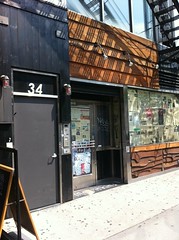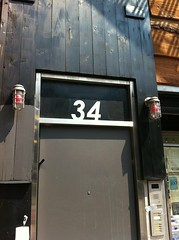I felt very young last week, sitting at the Community Board 3 meeting at 200 East Fifth Street. Being 21 years old, there were surely other attendees my age, or younger. But I could not beat the feeling that our voices and spirits were being silenced. I say this mostly because, as the Community Board again refused to support the application for a new experimental music venue at 34 Avenue A (formerly Mo Pitkins), a project of the music promoter Todd Patrick and Two Boots owner Phil Hartman, I felt like one of the few attendees who genuinely understood the cultural significance of what their proposed space, The Piney Woods, could be.
Imagine my surprise yesterday afternoon, when, flicking through Gmail on my iPhone, I found a response from Richard Hell, musician, punk innovator, East Village resident,and one of the most influential musical figures to come out of the neighborhood, in support of the application. The board is scheduled to consider it again at its meeting tonight.
“The Lower East Side needs a specialized, non-pop music room for musicians who are in it for other things than head-banging or making it big,” Mr. Hell told me. “Headbanging and raw ambition are fine, but there are plenty of venues for that already, and the Lower East Side would do well to maintain or recover its tradition of cutting edge art.”
Cutting edge music has moved to Brooklyn, but I see the benefit of having live music experiences situated in historically important neighborhoods. Working in the city today, as a music writer, radio DJ, and occasional promoter of DIY shows, I am at once totally absorbed by Brooklyn’s DIY music culture which Mr. Patrick helped create over the past decade, and continues to perpetuate; but I’ve also spent the past decade of my life steeped in the words and sounds of Downtown’s various musical legacies.
Last week, I felt like I was watching a new chapter in the city’s cultural history unfold, as I witnessed the Community Board negotiate various stipulations for the venue. In fact, I almost tweeted about it. But then they stopped. The application was blocked.
It would be culturally irresponsible to deny the Piney Woods the licenses it needs. But throughout last week’s meeting, nothing seemed clear. Many of the board members are largely unaware of the cultural history of the neighborhood they represent. Many of them were, without a doubt, unqualified to make an informed decision regarding the arts in the East Village.
The cultural importance and legitimacy of a small, boutique space which would promote avant-garde sounds – a hybrid of new and old ideologies, and a historical landmark of sorts – cannot be minimized and demeaned to the extent the board did at last week’s meeting. This space would not be the sort of noisy bar the Community Board apparently fears, although they’ve failed to realize that at two meetings already.
Bryan Waterman, a NoLiTa resident and associate professor of English at NYU, teaches the courses “Writing New York” and “The Downtown Scene in the 70’s,” both of which I took during my time at NYU. Professor Waterman wrote me yesterday, in support of the venue, emphasizing downtown Manhattan’s legacy as a hub for experimental music “from John Cage’s arrival on the Lower East Side in 1949 to John Zorn’s founding the Stone in 2005.”
Citing such past venues as The Kitchen, 135 Grand, Tonic, the Knitting Factory, and the soon-to-relocate Soho space Roulette – and such genres as free jazz, loft jazz, tape music, and No Wave – Professor Waterman said, “It’s hard to imagine a richer environment for new music to flourish in. But we’ve seen space after space vanish downtown.”
“SoHo’s basically a high end mall now,” wrote Professor Waterman, who also just published a volume for the 33 1/3 series on Television’s album “Marquee Moon.”
“You hear East Villagers lament all the time that their cultural legacy is being supplanted, too, but by beer pong. Well, here we have a chance to bring back some of what we lost when Tonic closed. The proposal I’ve seen would create a new music venue for a new era, but it also helps preserve the neighborhood’s rich musical heritage. It would enrich the East Village, not threaten it.”
Some community members are worried that Mr. Patrick and Mr. Hartman could sell off their liquor license if the business fails. Mr. Patrick’s experience growing a dozen New York music venues, including Cakeshop and Glasshouse (now, Glasslands), indicates that he’s opposed to perpetuating the sort of fratty bar culture East Villagers fear. He has perpetually put the integrity of his work first, always making an all-ages, low cost atmosphere a priority. Ethics have governed the way he works, as they do for anyone who commits their life to DIY culture.
Noise complaints also seem largely irrelevant as far as The Piney Woods is concerned, since the space would focus on musical modes that generally cannot be classified as “loud.” Indeed, the space would likely be on the quieter side of the venue spectrum. It appears there have also been complaints about the number of patrons pouring onto the streets at closing time. The venue’s capacity, however, is low, and the segment of music fans that go for avant-garde, experimental sounds — people like me — though robust, are not a rowdy bunch. They are generally intellectual, considerate, and the complete opposite of the bar culture the Community Board is scared of. They do not, whatsoever, follow that contemporary East Village penchant to “rage.”
I no longer live Downtown, but I remember the day I found out the old Knitting Factory was closing; and I remember when CBGB’s closed (I didn’t really care); and I remember the day during my freshman year when Webster Hall stopped feeling cool. I also remember the first time I ever went to “a Todd P. show” in Brooklyn, that same year, and the feeling of something genuinely authentic and exciting happening that was so much more interesting than anything I’d experienced, musically, in Manhattan. It’s time to resurrect what’s been lost.
The proposed music space would at once revive the neighborhood’s musical spirit, offering a low-key cultural goldmine that would increase the value of the neighborhood, combat East Village’s increasingly unbearable bar culture, and keep away the McDonald’s or Subway that will almost certainly go in its place. The Piney Woods is, indeed, the resolution the East Village seeks.
Join the conversation: What do you think of the plan for Piney Woods?






